
Mbuna is the common name for a large group of African cichlids from Lake Malawi, and are members of the haplochromine family. The name mbuna means "rockfish" in the language of the Tonga people of Malawi. As the name implies, most mbuna are cichlids that live among the piles of rocks and along the rocky shores of Lake Malawi, as opposed to the utaka, cichlids that live in the open water or on sandy shores or soft substrates. Some species of mbuna are highly sexually dimorphic, although many are not. Among biologists, almost all of the cichlid species of Lake Malawi, including mbuna and non mbuna such as the utaka, are believed to have descended from one or a very few species that became isolated in the lake. With rising water levels, new habitats could be colonized and the many isolated rocky outcrops allowed new mbuna species to form. Their striking colors, intriguing behavioral characteristics, and relative hardiness make them very popular despite their unique demands for the home aquarist.

Maylandia estherae is a haplochromine cichlid. It is a rock dwelling fish or mbuna from Lake Malawi. This fish, like most cichlids from Lake Malawi, is a mouthbrooder - females hold their fertilized eggs then fry in their mouths until they are released after about 21 days.

Pseudotropheus is a genus of fishes in the family Cichlidae. These mbuna cichlids are endemic to Lake Malawi in Eastern Africa.

Maylandia or Metriaclima is a genus of haplochromine cichlids endemic to Lake Malawi in East Africa. They belong to the mbuna (rock-dwelling) haplochromines.
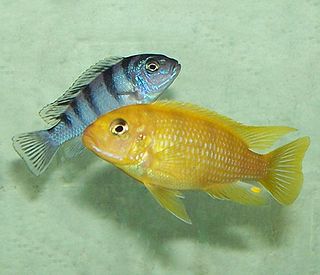
Maylandia lombardoi, is a 13 centimetres (5.1 in) long freshwater fish from the family Cichlidae. This species is popular in the aquarium hobby where it is sold under a variety of common names including: lombardoi mbuna, kenyi mbuna or kennyi mbuna or kenyi cichlid. This species is sometimes seen in the genus Metriaclima owing to a dispute in which a minority of cichlid researchers do not consider Maylandia valid (see Maylandia for discussion. The specific name honours the exotic fish dealer John Lombardo.
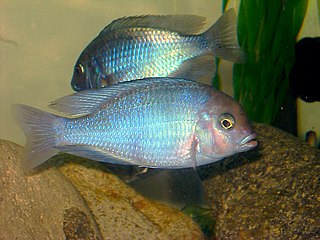
Cyrtocara moorii, commonly known as the hump-head, is a species of haplochromine cichlid endemic to Lake Malawi in east Africa where they prefer areas with sandy substrates. It can grow to a length of 20 centimetres (7.9 in) TL. The species is popular among aquarium keepers where it is known as the hump-head cichlid, blue dolphin cichlid, Malawi dolphin or simply as moorii. It is currently the only known member of its genus. The specific name honours the English cytologist and biologist John Edmund Sharrock Moore (1870-1947).

Pseudotropheus crabro, the Bumblebee Cichlid or Hornet Cichlid, is a species of cichlid endemic to Lake Malawi where it is found in different habitats but most frequently in large caves or in the vicinity of large boulders. This species can reach a length of 16 centimetres (6.3 in) SL.

Iodotropheus sprengerae, the rusty cichlid, lavender mbuna or lavender cichlid, is a species of cichlid endemic to the Boadzulu and Chinyankwazi Islands and Chinyamwezi Island regions of Lake Malawi. It prefers a temperature range of 24-26 °C.

Copadichromis borleyi is a species of haplochromine cichlid fish endemic to Lake Malawi in East Africa. The species is popular in the fishkeeping hobby where it is frequently kept in aquariums. The species has numerous common names, including redfin hap and goldfin hap.

The nkhomo-benga peacock, also known as the new yellow regal peacock, is a species of haplochromine cichlid which is endemic to Lake Malawi. This species is threatened by capture for the aquarium trade.

The blue mbuna is a species of cichlid found in Lake Malawi where it inhabits areas with rocky substrates. This species can reach a length of 30 centimetres (12 in) SL. This species is important to local commercial fisheries as well as being found in the aquarium trade. Some of its mottled forms are sometimes known as marmalade cat.
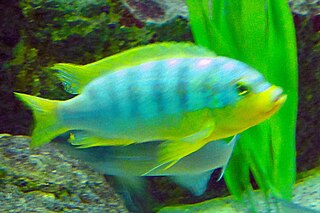
William's mbuna, also known as ice blue zebra mbuna or ice blue zebra or the Pseudotropheus ice blue among the aquarium enthusiasts, is a species of cichlid fish endemic to Lake Malawi where it is only found at Makokola in the southeastern arm of the lake. This species can reach a length of 13.4 centimetres (5.3 in) TL. It can also be found in the aquarium trade. The specific name honours the German ornamental fish importer Alfons Greshake.
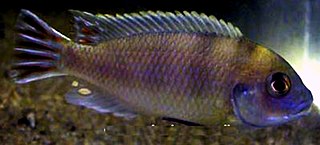
Maylandia livingstonii is a species of cichlid native to Lake Malawi and Lake Malombe. This species can reach a length of 15 centimetres (5.9 in) TL. It can also be found in the aquarium trade. The specific name of this fish honours the Scottish explorer and missionary David Livingstone (1813-1873).

Pseudotropheus cyaneorhabdos is a species of cichlid endemic to Lake Malawi where it is only known from around Likoma Island where it prefers rocky substrates at depths of from 5 to 10 metres. This species can grow to a length of 7.5 centimetres (3.0 in) SL. Also known as Maingano, this mbuna is often confused with P. johannii. One important distinguishing characteristic is that females are not orange, whereas female P. johanii are. Both male & female P. cyaneorhabdos are colored the same; however, males may have more intense coloring, particularly in dominant or sexually active males. Another key distinguishing feature of P. cyaneorhabdos from P. johannii is the lack of vertical stripes. The horizontal stripes of P. cyaneorhabdos have been used to study the genetic control of phenotypic traits like coloration.

The pearl of Likoma is a species of fish in the family Cichlidae endemic to Lake Malawi where it is native to rocky areas around Likoma Island and it has been introduced to Thumbi West Island. This species can reach a length of 10 centimetres (3.9 in) TL. It can also be found in the aquarium trade. Males are blue, while females are a greenish blue with rows of yellowish spots and shiny gills. They feed on crustaceans, insects, and larvae.
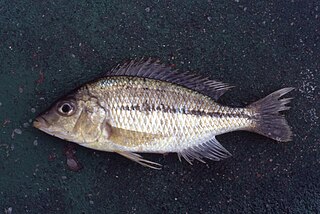
Protomelas kirkii is a species of cichlid endemic to Lake Malawi where it is most commonly found in areas vegetated with Vallisneria. This species can reach a length of 18 centimetres (7.1 in) TL. This species can also be found in the aquarium trade.

Pseudotropheus demasoni is a species of cichlid endemic to Lake Malawi where it is only known from the Pombo Rocks in Tanzanian waters. This species can potentially reach a maximum length of 10 centimetres (3.9 in) SL. It is now commonly found in the aquarium trade.

Pseudotropheus saulosi is a species of cichlid endemic to Lake Malawi in East Africa, where it lives in areas with rocky substrates. It is classified as a dwarf-mbuna and was first described by Ad Konings in 1990, who gave it the specific name saulosi in honour of Saulos Mwale who caught over 3,000 specimens in a single day on the expedition which collected the type. It comes from an area of the lake called Taiwan Reef, and from nowhere else. This fish can also be found in the aquarium trade.

The pindani is a species of cichlid endemic to Lake Malawi preferring areas with sandy substrates and nearby rocks where the males establish their territories. This species can reach a length of 6.7 centimetres (2.6 in) SL. It can also be found in the aquarium trade. The specific name of this fish honours the aquarium fish trader Ross Socolof (1925-2009).

The red top williamsi is a species of cichlid endemic to Lake Malawi where it occurs in areas with rocky substrates usually at depths of less than 2 metres (6.6 ft). This species can reach a length of 16.5 centimetres (6.5 in) TL. It can also be found in the aquarium trade. The specific name honours the Anglican missionary Joseph A. Williams who died by drowning in Lake Malawi in 1895, with Bishop Chauncy Maples, and who collected the type of the cichlid among others.




















